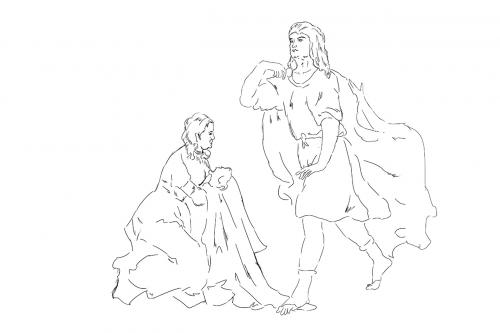



Potiphar’s Wife Falsely Accusing Joseph
The story of Patriarch Joseph’s youth has often been a source in Christian literature, allegorically foretelling Jesus’ life. Themes such as “The Selling of Joseph into Slavery”, “Joseph and Potiphar’s Wife”, or “Potiphar’s Wife Falsely Accusing Joseph” were seen as parallels to “Judah’s Treason”, “The Temptation of Christ” and “Jesus’ Process”. Although these are Old Testament references frequently employed, the scenes from Joseph’s life have been less evoked in Byzantine and Post-Byzantine art, compared to the notoriety they enjoyed in Western art since Early Christianity. That is why there are no explicit canons for such iconographical representations.
The scene “Potiphar’s Wife Falsely Accusing Joseph” is scarcely present in Byzantine and Post-Byzantine art as the illustration of the next verse, that relating about Joseph’s imprisonment is preferred. However, when the episode of Joseph’s accusation is represented, in the most simple composition, only two characters are present: Potiphar and his wife. More complex compositions may include secondary characters like the servants or even the captured Joseph. The characters are viewed in profile or semi-profile. Potiphar is standing or sitting, his wife, in front of him, either bowing or kneeling, is presenting Joseph’s abandoned coat. Both are richly dressed. In more elaborate representations the scene of the accusation is continued with that of Joseph’s way to jail. Auxiliary characters are used to connect the two illustrations.
The story of Patriarch Joseph’s youth has often been a source in Christian literature, allegorically foretelling Jesus’ life. Themes such as “The Selling of Joseph into Slavery”, “Joseph and Potiphar’s Wife”, or “Potiphar’s Wife Falsely Accusing Joseph” were seen as parallels to “Judah’s Treason”, “The Temptation of Christ” and “Jesus’ Process”. Although these are Old Testament references frequently employed, the scenes from Joseph’s life have been less evoked in Byzantine and Post-Byzantine art, compared to the notoriety they enjoyed in Western art since Early Christianity. That is why there are no explicit canons for such iconographical representations.
The scene “Potiphar’s Wife Falsely Accusing Joseph” is scarcely present in Byzantine and Post-Byzantine art as the illustration of the next verse, that relating about Joseph’s imprisonment is preferred. However, when the episode of Joseph’s accusation is represented, in the most simple composition, only two characters are present: Potiphar and his wife. More complex compositions may include secondary characters like the servants or even the captured Joseph. The characters are viewed in profile or semi-profile. Potiphar is standing or sitting, his wife, in front of him, either bowing or kneeling, is presenting Joseph’s abandoned coat. Both are richly dressed. In more elaborate representations the scene of the accusation is continued with that of Joseph’s way to jail. Auxiliary characters are used to connect the two illustrations.




